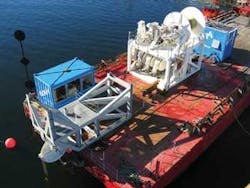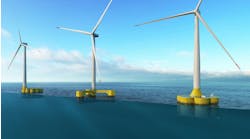Fiber rope logs excellent record in ultra-deepwater lifting operations
Traditionally, steel wire rope has been used as lift line in offshore lifting operations. But wire rope lifting lines have limitations, particularly in deepwater, due primarily to their weight.
Use of lighter, high-strength synthetic fiber ropes instead of steel wire for lifting lines substantially reduces the size and weight of the handling system. This, in turn, provides offshore operators with a larger range of vessel choice for deepwater construction.
However, using fiber rope lifting lines is not completely without challenges. Major differences exist between fiber ropes and steel wire rope. When developing a fiber rope handling system, such issues as lower stiffness, sensitivity to heat, abrasive wear and tear, and low coefficient of friction should be considered, since any or all of them will cause severe wear to and premature failure of fiber rope.
Deploying fiber rope as a “system”
Development of a fiber rope deployment system (FRDS) requires a systems approach. Consideration should be given to its specific properties, as well as to development of a suitable handling system and qualifying and validating the complete system through testing and field experience.
Important features defined for fiber ropes used as lifting lines in heave-compensated systems are:
- High cyclic bend-over sheave performance
- Torque-free construction
- Comparative ease of field inspection and repair
- High strength-to-weight ratio
The fiber rope from Puget Sound Rope used in a recent North Sea-area development is “braid-optimized for bending” (BOB) and is based on a 12 x 12 braided construction. This assures a torque-free rope and at the same time, a rope that can easily be inspected internally and repaired offshore
A blend of high-modulus poly ethylene (HMPE) and liquid crystal polymer (LCP) fibers is used to provide good temperature resistance and positive creep properties for Puget Sound’s fiber rope product. A lubricant coating also is used to reduce friction between fibers, thereby avoiding internal wear and heat buildup in cyclic bend-over sheave operations, according to the company.
For an FRDS, the need for a traction unit between the load side and the storage side is crucial due to the huge difference between deployment of a heavy load and recovery of an empty hook with neutrally buoyant lifting line. Recovery of an empty hook without a traction unit would lead to the fiber rope spooling onto the storage drum at very low tension, which could create problems with squeezing the rope into soft layers during subsequent installations.
Conventional traction winch systems designed specifically for use with steel wire are not directly applicable for fiber rope. Damaging slip will occur and splice-handling ability is limited.
A traction unit specially developed for fiber rope - the Cable Traction Control Unit (CTCU) - is patented by the Norwegian company, ODIM. The CTCU consists of a number of individually driven sheaves. Thus, speed and torque on each sheave can be controlled to avoid accumulated slip due to rope elongation. Furthermore, splices and other objects can easily be handled.
The FRDS system includes:
- CTCU: A series of sheaves with individual drives used to de-tension the rope with associated power pack and accumulators.
- Storage winch to store the rope at low tension and assure a constant back tension for the CTCU.
- Control System: for dynamic control of individual machines and interactions between machines. The control system also includes a rope management system.
System functionality includes:
- High-speed deployment of heavy loads
- High-speed deployment and recovery of an empty hook
- Powerful and accurate active heave compensation: Speed capacity of 6.5 ft/sec. (2 m/sec.) and 95% accuracy
- Accurate constant tensioning function
- Pull limit: Active limitation of allowed pulling force. This can also be extended to a splash zone transition function to avoid peak loads or slack slings during splash zone transition.
- Automatic landing function: Automatic transition from AHC to CT upon landing
- Automatic liftoff function: Automatic transition from CT to AHC during liftoff
Management system for fiber rope
Cyclic bending over a sheave will occur in active heave-compensation operations. Real-time knowledge of the condition at any point of the rope is crucial to avoiding failure and using the rope asset efficiently.
Being repairable, fiber rope provides operators with an opportunity to use its excellent fatigue life along the entire length of the rope. However, this further emphasizes the need for a reliable system for monitoring and managing the condition of the rope as its configuration changes, such as after cutting and splicing, for example.
For the CTCU-based FRDS, ODIM has developed a Rope Management System (RMS) as an integral part of the winch control system. The rope is split into segments with configurable length - e.g. 0.33 m - for which rope data are recorded, processed, and displayed in real time on the winch operator’s computer. Alarms for inspection and replacement of rope segments that have reached a configurable alarm limit also are implemented as part of the FRDS alarm system.
When a section of rope has reached its retirement criteria, or even if the operator simply wants to check the actual condition of the rope, the section is cut out and sent to the laboratory for residual strength testing. Based on break test results, the rope’s retirement criteria and weighing formulae can be updated and improved. Thus, the RMS is a powerful tool to speed up and assure quality in rope wear and retirement calculations, the company says.
Recent pilot system deployment
A 46-mT, SWL Fiber Rope Deployment System was built and tested in 2003-2004 in a Demo 2000 funded JIP managed by the Norwegian company ODIM. This system was tested on land and on a barge.
Det Norske Veritas (DNV) witnessed all tests, including single fall and four-fall configuration testing, both on shore and aboard the barge.
Norsk Hydro provided the JIP with an opportunity to install three gravity anchors at a water depth of about 2,800 ft (855 m) as a field pilot in the Ormen Lange gas field off the west coast of Norway. Deployment calculations showed that resonant conditions could be expected during deployment and landing. Active heave compensation proved to be an efficient way to control payloads during resonant conditions.
Ultra deepwater Gulf of Mexico installations
In January 2006, Subsea 7 elected to use the CTCU-based Fiber Rope Deployment System for an ultra-deepwater installation contract in the Gulf of Mexico.
The scope of work for the FRDS consisted of installation and construction. Mud mats, manifolds, a production tree, spool pieces, and jumpers were installed, and umbilical heads deployed and stabbed.
To date (May 2007), more than 170 deployments in water depths to 9,020 ft (2,750 m) were performed during the previous eight months. The first system inspection, performed recently after 150 lifts, showed the rope to be in good condition. The next step will be to cut out a section of rope and send it to the laboratory for residual break tests.
Summing it up, the FRDS - including the fiber rope - has performed well, with no major problems.
For more information about the CTCU contact[email protected], www.odim.no.
For more information about the ROPE contact[email protected], www.thecortlandcompanies.com






